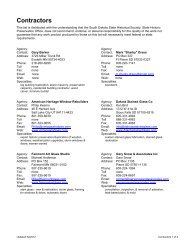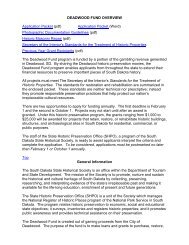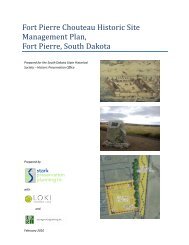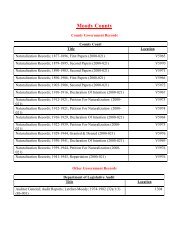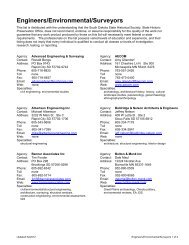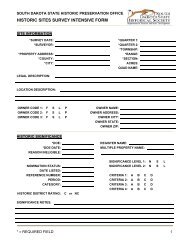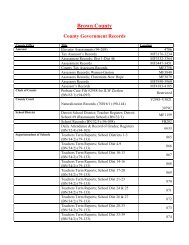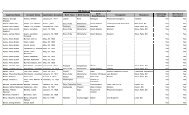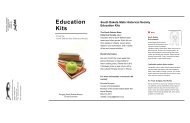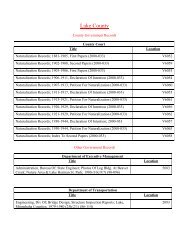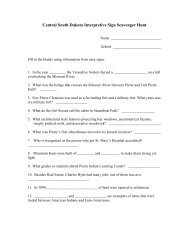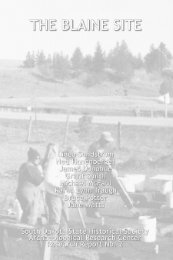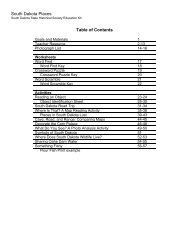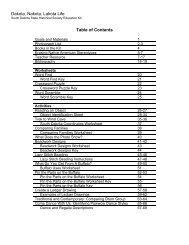A Geoarchaeological Overview of South Dakota and Preliminary
A Geoarchaeological Overview of South Dakota and Preliminary
A Geoarchaeological Overview of South Dakota and Preliminary
You also want an ePaper? Increase the reach of your titles
YUMPU automatically turns print PDFs into web optimized ePapers that Google loves.
DRAFT DRAFT DRAFT<br />
components. The basic rational for trench numbers <strong>and</strong> placement should be outlined by the survey team<br />
as part <strong>of</strong> the work plan supplied to Mn/DOT” (Monaghan et al. (2005).<br />
Excavation to as deep as the backhoe will reach, ca. 3-4 m, is recommended unless the water table or<br />
basal deposits are encountered. The protocol stipulates methods for pr<strong>of</strong>iling, flotation sampling, <strong>and</strong><br />
radiocarbon dating.<br />
Like trenching, coring or augering first establishes the depth to basal deposits.<br />
The principal goal <strong>of</strong> the coring process is to identify stratigraphic horizons that represent stable<br />
surfaces <strong>of</strong> an age compatible with human occupation. These are identified based on their<br />
stratigraphical, pedological, <strong>and</strong> sedimentological characteristics. The depths to the top <strong>and</strong> base <strong>of</strong> these<br />
horizons are defined based on the core data, <strong>and</strong> then these target horizons are sampled with augers for<br />
the buried archaeological materials.<br />
To sample the “target horizons” using augers, the protocol pilot project used mechanically-drilled<br />
flight augers, 10-13 cm in diameter <strong>and</strong> (typically) 1.2-1.8 m long. An example <strong>of</strong> a flight auger is the<br />
screw-type drill attached to the power augers commonly used for subsurface testing in the <strong>Dakota</strong>s.<br />
Those used on core <strong>and</strong> drill rigs are designed to connect together into long, continuous strings, called<br />
“flights.” The pilot study did augering on 20 m grids. At each point on the grid, multiple auger holes<br />
were drilled, enough to test a sampling volume equivalent to that <strong>of</strong> a 25 cm diameter shovel test. This<br />
required 4-6 individual holes, depending on auger diameter.<br />
Discussion<br />
The guidelines presented above view deep testing as part <strong>of</strong> Level-III-equivalent intensive survey. A<br />
difference between them is that Iowa’s recommends that geomorphological study be conducted in<br />
advance <strong>of</strong> the archaeological survey (Association <strong>of</strong> Iowa Archaeologists 1993). The rationale is that<br />
archaeological survey <strong>of</strong> alluvial, colluvial, <strong>and</strong> eolian l<strong>and</strong>scapes should not begin until the<br />
archaeologists know about subsurface conditions. For example, pedestrian surface survey need not be<br />
undertaken in areas covered or entirely underlain by historic-period alluvium, where surface prehistoric<br />
sites will not exist. Further, the premise is that, prior to starting subsurface testing, archaeologists should<br />
know where <strong>and</strong> how deep testing should extend.<br />
In practice, in Iowa, the additional time <strong>and</strong> cost <strong>of</strong> “doing the geomorphology first” has proven to be<br />
impractical except for relatively large projects where complex depositional sequences make an initial<br />
geomorphological investigation essential. For small <strong>and</strong> quite a few large projects, archaeologists<br />
working in Iowa generally do the geomorphology “as they go.”<br />
The Minnesota protocol summarizes the relationship between geomorphological <strong>and</strong> archaeological<br />
investigations as follows,<br />
“The discovery <strong>and</strong> evaluation <strong>of</strong> buried archaeological sites is a multidisciplinary task that focuses<br />
on two different aspects <strong>of</strong> geoarchaeology. The first, discovery, emphasizes the “geology” <strong>of</strong><br />
geoarchaeology while the second, evaluation, focuses on the “archaeology” <strong>of</strong> the discipline.”<br />
To that extent, the Indiana guidelines <strong>and</strong> Minnesota protocol, as well as other states, establish a<br />
methodological approach that accomplishes both the geology <strong>and</strong> the archaeology at the same time. For<br />
example, both documents recommend that trenching proceed in systematic intervals, carefully peeled<br />
back with a smooth-bladed bucket to find artifacts as well as expose stratigraphy. Flight-augering in the<br />
Minnesota protocol is designed to sample volumes equivalent to a st<strong>and</strong>ard shovel test.<br />
Not surprisingly, in the field, the Iowa “do it first” <strong>and</strong> Minnesota/Indiana “do it together” approaches<br />
are rarely mutually exclusive. The Minnesota protocol requires that subsurface testing begin with a<br />
geologically oriented effort to find the depth to basal deposits, followed by closer interval trenching or<br />
augering to search for sites. In Iowa, archaeologists will frequently skip over, or widen sampling<br />
42



